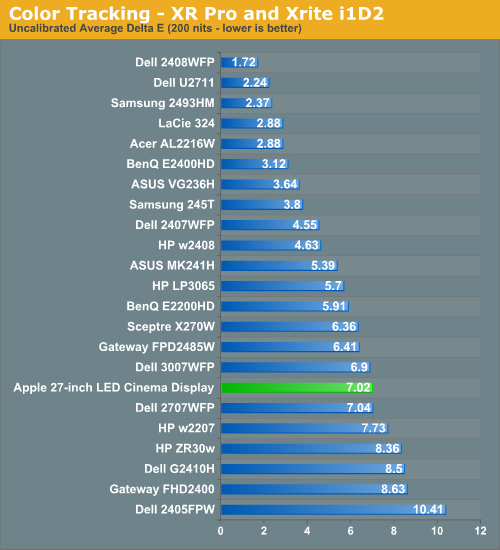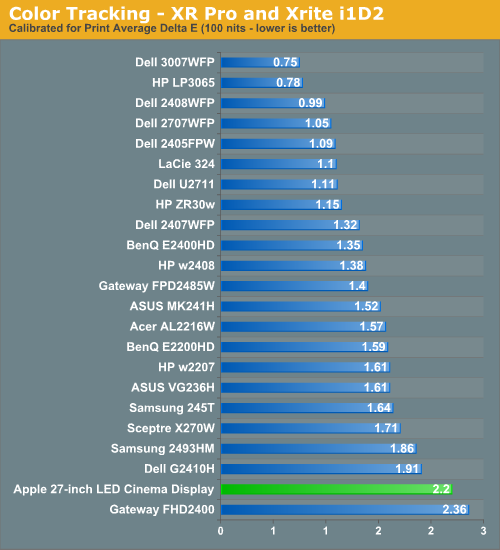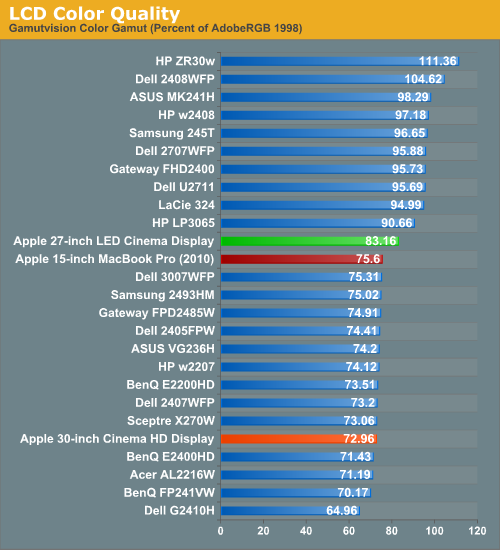Apple 27-inch LED Cinema Display Review
by Anand Lal Shimpi on September 28, 2010 12:15 AM EST- Posted in
- Displays
- Mac
- Apple
- Cinema Display
Color Quality
We report two main quality metrics in our display reviews: color accuracy (Delta-E) and color gamut. Color gamut refers to the range of colors the display is able to represent with respect to some color space. In this case, our reference is the AdobeRGB 1998 color space, which is larger than the sRGB color space. So our percentages are reported with respect to this number, and larger is generally better.
Color accuracy (Delta E) refers to the display’s ability to display the correct color requested by the GPU and OS. The difference between the color represented by the display, and the color requested by the GPU is our Delta-E, and lower is better here. In practice, a Delta E under 1.0 is perfect - the chromatic sensitivity of the human eye is not great enough to distinguish a difference. Moving up, a Delta E of 2.0 or less is generally considered fit for use in a professional imaging environment - it isn’t perfect, but it’s hard to gauge the difference. Finally, Delta E of 4.0 and above is considered visible with the human eye. Of course, the big consideration here is frame of reference; unless you have another monitor or some print samples (color checker card) to compare your display with, you probably won’t notice. That is, until you print or view media on another monitor. Then the difference will no doubt be apparent.
As I mentioned in our earlier reviews, we’ve updated our display test bench. We’ve deprecated the Monaco Optix XR Pro colorimeter in favor of an Xrite i1D2 since there are no longer up-to-date drivers for modern platforms.
For these tests, we calibrate the display and try to obtain the best Delta-E we can get at both 200 nits of brightness for normal use, and 100 nits for print brightness. We target 6500K and a gamma of 2.2, but sometimes the best performance lies at native temperature and another gamma, so we try to find what the absolute best performance could be. We also take an uncalibrated measurement to show performance out of the box using either the manufacturer supplied color profile, or a generic one with no LUT data. For all of these, dynamic contrast is disabled.


Uncalibrated the display's color accuracy isn't very good. I found the 27-inch LED Cinema Display to be way too blue and green out of the box, calibrated the display did much better:


The 27-inch LED Cinema Display isn't going to be winning any awards for color reproduction but it's good enough when calibrated.


Curiously enough, dropping brightness down to 100 nits caused a noticeable reduction in color tracking. The average delta E went up to 2.2 while most of the 27's competitors remained about the same. The 27-inch behaves very differently depending on what brightness setting you have it on.

Apple managed to do relatively well with the WLED backlight but it's still no match for the color gamut you get from any of the CCFL backlit displays. Note that my old 30 hasn't aged well, it's only able to cover roughly 73% today.











93 Comments
View All Comments
andy o - Tuesday, September 28, 2010 - link
Just in case, I'm talking as opposed to 16:10 ratio. That's wide enough. The 2560x1600 resolution stays barely alive with the 30" screens as you say, but the 1920x1200 and especially the 1680x1050 resolutions are all but dead already.If I wanted another laptop like the one I have with a 1680x1050 res on a 15" or so screen, can I get that anymore? The closest I've seen is 1600x900 which already seems too low.
fabarati - Tuesday, September 28, 2010 - link
Anand was getting jigyy with it!Also, not only is the resolutiion 90% of 2560x1600, the size is also 90% of the 30".
ytoledano1 - Tuesday, September 28, 2010 - link
27" is 81% of 30", when comparing areas, you need to square the ratio.A pixel pitch of 0.25 for 2560x1600 @ 30" is already tiny, with 0.23 for 2560x1440 @ 27" I'll probably have to use bigger fonts everywhere and still have problems with some applications.
ijhammo - Tuesday, September 28, 2010 - link
erm 27" is referring to diagonal length, so the 27" screen diagonal is 90% of the 30" screen diagonal. Also, pixel count is 90% too.chris1317 - Tuesday, September 28, 2010 - link
16:9 is really the worst aspect ratio I have used on a computer screen. Although the difference does not seem much on paper when you actually use one you can see what a backwards step it is. I think I will stick with my 1920x1200 display for now until the manufacturers see some sense and supply what im after.piroroadkill - Tuesday, September 28, 2010 - link
Dell already does the perfect monitors, you just have to be able to afford them.Way better than this Apple offering..
http://accessories.us.dell.com/sna/products/Displa...
IceDread - Tuesday, September 28, 2010 - link
Actually, I prefer HP monitors above dell. Dell may have more options but the color on dell aint good. It is common that it's way to dark on the right side when you have a white background.The game mode is green/ blueish so you are stuck with high input lag in games if you want decent colours.
So I actually prefer HP in this case.
YouGotServed - Friday, October 1, 2010 - link
You sir, are speaking out of your butt. Please get facts straight before speaking.http://accessories.us.dell.com/sna/products/Displa...
This is the pinnacle of Dell monitors. If you can find a comparable HP display, I will be impressed.
IceDread - Tuesday, September 28, 2010 - link
I agree. A 27" 16:9 is like a 24" 16:10. The loss of height is very annoying.I think it's a sales trick. They write 27" and think they can charge you more for it.
jasperjones - Tuesday, September 28, 2010 - link
Seems the U2711, which received an Gold Editor's choice award from AT, is still the way to go for anyone except hardcore Apple fanbois.